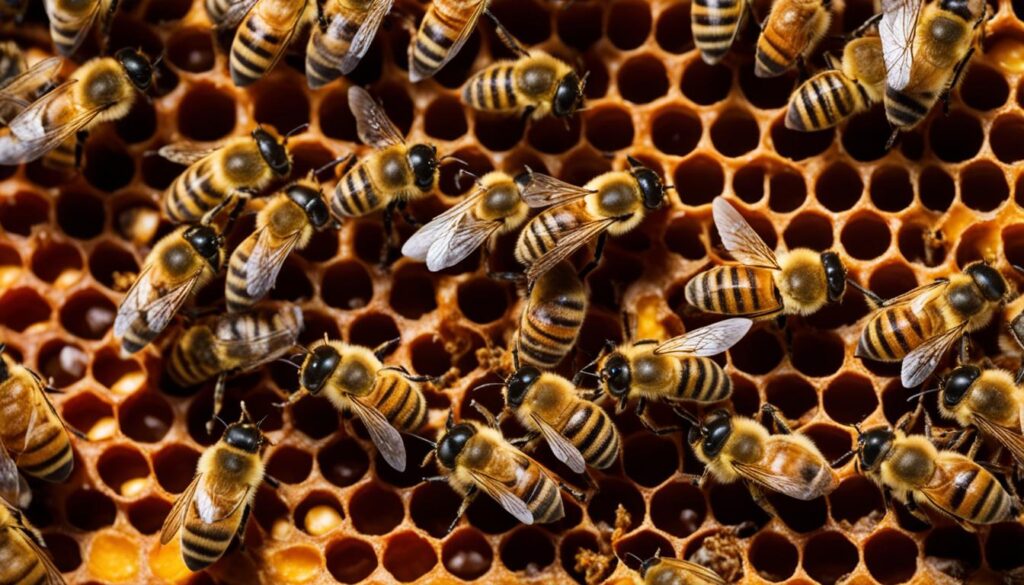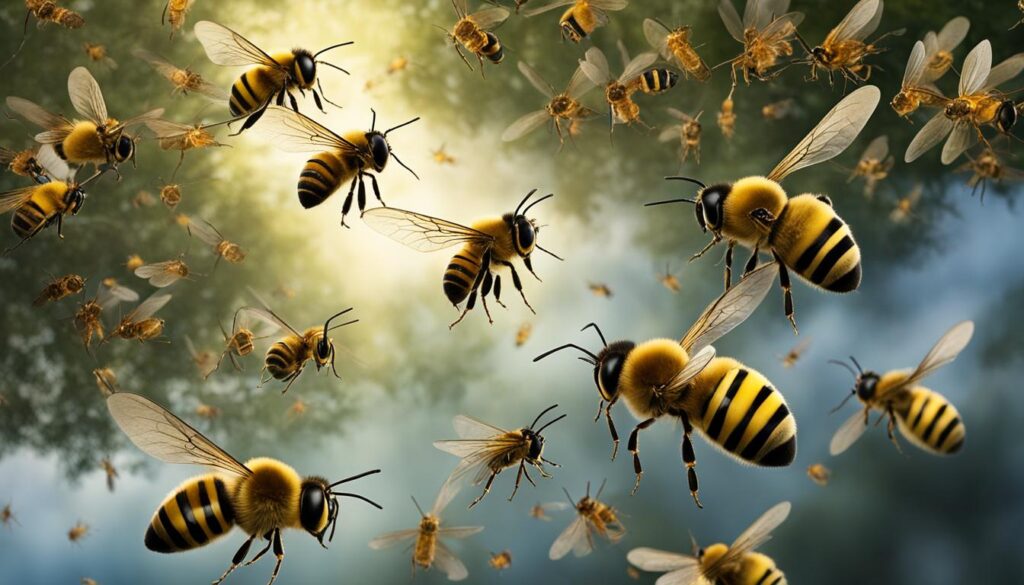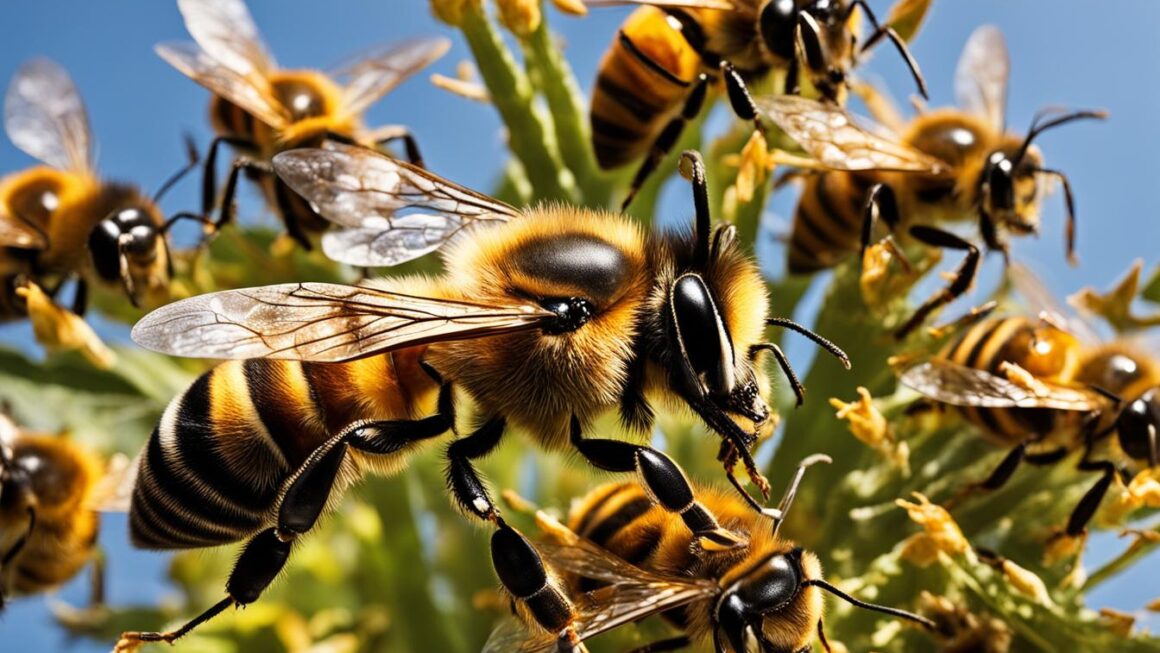Queen bees are fascinating creatures with unique behaviors and roles within a beehive. One common question that arises is whether queen bees have stingers and if they sting humans. In this article, we will explore the stinging behavior of queen bees, their stinger physiology, and their interactions with humans.
According to multiple sources, including Wildflower Meadows and Smore Science, queen bees do have stingers but they rarely use them to sting humans. They reserve their stinging behavior for other queen bees. Queen bees have a smooth stinger, unlike worker bees, which means they can theoretically sting multiple times without dying. The purpose of the queen bee’s stinger is to defend against rival queens. They also sting the developing queen pupae inside queen cells to eliminate any potential competition.
Key Takeaways:
- Queen bees have stingers but rarely use them to sting humans.
- Their stingers are smooth, allowing them to sting multiple times without harm.
- Queen bees primarily use their stingers to defend against rival queens and eliminate competition.
Queen Bee Stinger vs. Worker Bee Stinger
When it comes to stinging behavior, there are distinct differences between the queen bee and worker bee. The stinger of a queen bee is smooth and not barbed, allowing her to sting multiple times without losing her stinger and dying. In contrast, when a worker bee stings, its barbed stinger becomes lodged in the victim’s skin, causing the bee’s stinger and venom sac to be detached from its body, ultimately resulting in the worker bee’s death.
This contrast in stinger physiology has significant implications for the stinging behavior of queen bees versus worker bees. While queen bees primarily use their stingers to defend against rival queens during fights-to-the-death, worker bees are more likely to sting humans or other perceived threats to the hive’s safety. The smooth stinger of the queen bee allows for multiple stings without sacrificing her life, while the barbed stinger of the worker bee acts as a deterrent, discouraging repeated stinging.
Queen Bee Stinger vs. Worker Bee Stinger
| Queen Bee Stinger | Worker Bee Stinger |
|---|---|
| Smooth and not barbed | Barbed |
| Allows for multiple stings | Becomes detached after one sting |
| Used primarily against rival queens | Used for defense against threats to the hive |
Overall, the distinct stinging behaviors of queen bees and worker bees highlight the specialization and division of labor within a beehive. While the queen bee focuses on reproducing and maintaining the hierarchy, worker bees are responsible for protecting the hive and carrying out essential tasks such as foraging and caring for the brood. Understanding the differences between the queen bee stinger and the worker bee stinger provides insights into the complex social dynamics of bee colonies.
The Role of the Queen Bee’s Stinger
The queen bee’s stinger serves a crucial role in defending herself and the colony against rival queens. In a fight-to-the-death encounter, the queen bee uses her stinger to deliver a fatal blow to the opposing queen. This aggressive behavior ensures the maintenance of the hive’s hierarchy and stability. Additionally, queen bees may also sting the developing queen pupae inside queen cells to eliminate potential competition.
To highlight the importance of the queen bee’s stinger, it is essential to understand the dynamics of a beehive. While queen bees do not directly control the hive like monarchs, they have influence over the behavior of worker bees. The delicate hierarchy within the hive relies on the cooperation between queen bees and worker bees. Queen bees use their stingers to eliminate rival queens or mutinous workers seeking to displace them, thus preserving the stability and productivity of the hive.
“The aggression displayed by queen bees towards other queens highlights the importance of maintaining the hierarchy and stability within the hive.”
Queen Bee Aggression and Hierarchy
Queen bee aggression towards other queens is a natural instinct that ensures the survival of the strongest and most suitable queen. By eliminating rival queens, the dominant queen can maintain control over the hive and continue to reproduce, ensuring the growth and productivity of the colony. This aggression is driven by chemical signals and instinctive behavior, contributing to the intricate social structure of the hive.
In summary, the queen bee’s stinger plays a critical role in defending against rival queens, eliminating competition, and maintaining the hierarchy within the hive. This aggression and control over the hive’s dynamics are essential for the survival and productivity of the colony. Understanding the behavior and purpose of the queen bee’s stinger provides valuable insights into the fascinating world of honeybees and their complex social structure.
Queen Bee Stinging Behavior towards Humans
Despite having the ability to sting, queen bees rarely exhibit aggressive behavior towards humans. Beekeepers and experts report that queen bees generally do not sting humans, even in situations where there is direct contact. In fact, the sting of a queen bee is said to be less painful to humans compared to the sting of a worker bee. Queen bees are typically focused on their role within the hive, ensuring the reproduction and stability of the colony.
While queen bees may sting humans under exceptional circumstances such as during a relocation or nuptial flight, this behavior is not typical. Queen bees prioritize their interactions and stinging behavior towards other queen bees, defending their position and eliminating potential competition. The primary purpose of a queen bee’s stinger is to protect herself, the hive, and maintain the hierarchy within the colony.
“Queen bees generally do not sting humans, even in situations where there is direct contact. The sting of a queen bee is said to be less painful to humans compared to the sting of a worker bee.”
Queen bees possess a smooth stinger, allowing them to sting multiple times without the risk of dying. This contrasts with the barbed stinger of worker bees, which becomes lodged in the victim’s skin, causing the death of the worker bee. The differing stinging behaviors of queen bees and worker bees reflect their distinct roles and physiology within the hive.
Understanding the stinging behavior of queen bees towards humans sheds light on their complex social structure and their remarkable ability to maintain harmony within the hive. While queen bees may possess the capability to sting humans, their focus remains on the success and survival of their colony.
Table: Queen Bee Stinging Behavior
| Aspect | Queen Bee | Worker Bee |
|---|---|---|
| Stinger Type | Smooth | Barbed |
| Stinging Behavior towards Humans | Rarely stings | Stings, resulting in death |
| Stinging Behavior towards Queen Bees | Defends against rival queens | Rarely involved in queen duels |
| Stinging Behavior towards Worker Bees | May sting mutinous workers | Stings if threat perceived |
Queen Bee vs. Worker Bee Sting
The stinging behavior of queen bees and worker bees differs in several ways. Queen bees have a smooth stinger and can sting multiple times without being fatally injured, while worker bees have a barbed stinger that becomes lodged in the victim’s skin, leading to the worker bee’s death. Additionally, the sting of a queen bee is said to be less painful to humans compared to the sting of a worker bee.
The differences in stinging behavior reflect the distinct roles and physiology of queen bees and worker bees within the hive. Queen bees primarily use their stingers to defend against rival queens, ensuring the stability of the hive’s hierarchy. Their smooth stingers allow them to eliminate potential competition by stinging developing queen pupae inside queen cells. In contrast, worker bees use their stingers for defense and protection of the entire colony. When a worker bee stings a perceived threat, its barbed stinger becomes lodged, causing the worker bee’s death.
Understanding the differences in stinging behavior between queen bees and worker bees provides insight into their unique roles within the hive. While queen bees prioritize defending against rival queens, worker bees prioritize the safety and survival of the entire colony. These differences contribute to the overall productivity and functioning of the hive as a cohesive unit.
| Queen Bee Sting | Worker Bee Sting |
|---|---|
| Smooth stinger | Barbed stinger |
| Can sting multiple times without being fatally injured | Stinger becomes lodged, leading to the worker bee’s death |
| Less painful to humans compared to a worker bee sting | More painful to humans |
Overall, the stinging behavior of queen bees and worker bees highlights their distinct roles and adaptations within the hive. While both play essential roles, queen bees prioritize defense against rival queens, while worker bees focus on protecting the colony. These differences in stinging behavior underline the intricate social dynamics and division of labor that make bee colonies such fascinating and efficient societies.
Reproductive Role of Queen Bees
Queen bees play a crucial role in the reproductive cycle of a hive. With their remarkable ability to lay eggs, they ensure the continuation of the colony. A queen bee has the capacity to lay up to 1,500 eggs per day, contributing to the growth and sustainability of the hive.
Unlike worker bees, which can only lay unfertilized eggs that become drones, queen bees have the remarkable ability to lay both unfertilized and fertilized eggs. The fertilized eggs have the potential to become either worker bees or new queen bees, depending on the diet they receive during their development.
This reproductive process is essential for the hive’s survival. The ability of queen bees to produce a large number of eggs ensures a constant population of worker bees, which are responsible for foraging, nursing the young, and maintaining the hive. The queen bee’s role as the primary egg-layer is fundamental to the overall functioning of the colony.

| Role | Laying Capacity | Egg Types |
|---|---|---|
| Queen Bee | Up to 1,500 eggs per day | Both unfertilized and fertilized eggs |
| Worker Bee | Unable to lay fertilized eggs | Only unfertilized eggs (drones) |
Queen Bee Lifespan and Mating Behavior
Queen bees have a relatively long lifespan compared to other bees in the hive. On average, a queen bee can live for two to seven years, depending on various factors such as her health, genetics, and environmental conditions. The lifespan of a queen bee is influenced by the number of times she mates with drones (male bees). Interestingly, a queen bee mates only once in her life, during a specific period known as the nuptial flight.
During the nuptial flight, the queen bee leaves the hive and mates with as many drones as possible. This mating process is crucial for the survival and genetic diversity of the hive. After mating, the queen stores the collected sperm in a special organ called the spermatheca. She uses this stored sperm to fertilize eggs for the rest of her life. However, over time, the queen bee may run out of genetic material and need to be replaced by the beekeeper or the hive itself.
While the queen bee mates only once, she can lay a large number of eggs throughout her lifetime. Queen bees are prolific egg layers, capable of laying up to 1,500 eggs per day. These eggs have the potential to become either worker bees or queen bees, depending on the diet they receive during their development. The ability of queen bees to lay a high volume of fertilized and unfertilized eggs is crucial for the growth and productivity of the hive.
| Key Points | Queen Bee Lifespan and Mating Behavior |
|---|---|
| Lifespan | Two to seven years |
| Mating Behavior | Mates only once in her life during the nuptial flight |
| Egg-laying Capacity | Up to 1,500 eggs per day |
| Genetic Diversity | Crucial for the survival and productivity of the hive |
Queen Bee Lifespan and Reproduction: A Delicate Balance
The lifespan and mating behavior of queen bees play a crucial role in the dynamics of the hive. The longer a queen bee lives, the more eggs she can lay, ensuring the continuous growth and survival of the colony. However, as the queen ages and her stored sperm depletes, the hive may need to replace her with a new queen.
The mating behavior of queen bees, occurring only once in their lives, contributes to genetic diversity within the hive. By mating with multiple drones during the nuptial flight, the queen increases the chances of introducing different genetic traits into the colony. This genetic diversity enhances the resilience and adaptability of the hive to changing environmental conditions.
Understanding the lifespan and mating behavior of queen bees provides valuable insights into the complex social structure of beehives. These fascinating creatures continue to intrigue scientists and bee enthusiasts alike, as they exemplify the delicate balance between reproduction, genetic diversity, and hive dynamics.

Queen Bee and Hive Dynamics
Contrary to popular belief, queen bees do not rule over the hive like monarchs. The dynamics within a beehive are more democratic, with worker bees making decisions through chemical signals and instinctive behavior. Queen bees have influence over the behavior of worker bees but do not directly control them. The hierarchy within a hive is delicate, and queen bees may use their stingers to eliminate rival queens or mutinous workers seeking to displace them. The cooperation between queen bees and worker bees is essential for the survival and productivity of the hive.
Worker bees, the majority of the hive population, perform various tasks such as foraging for food, building and maintaining the hive, caring for the queen and her offspring, and defending the hive against predators. They communicate through pheromones, which convey messages about the hive’s health, the presence of the queen, and other important information. Worker bees have the ability to control the hive’s temperature by fanning their wings or clustering together, ensuring the well-being of the colony.
The queen bee’s role in the hive is primarily reproductive. She is responsible for laying eggs, ensuring the continuation of the colony. The queen bee emits pheromones that regulate the behavior and development of the worker bees. These pheromones suppress the reproductive systems of the worker bees, ensuring that only the queen bee has the ability to lay fertilized eggs. The presence of the queen’s pheromones also provides a sense of unity and purpose within the hive, promoting effective cooperation and productivity.
Queen Bee and Worker Bee Roles Comparison:
| Queen Bee | Worker Bee |
|---|---|
| Primary role is reproduction | Perform various tasks including foraging, hive maintenance, and defense |
| Uses stinger to eliminate rival queens and mutinous workers | Protects the hive by stinging predators |
| Emits pheromones to regulate the behavior of worker bees | Communicates through chemical signals and pheromones |
| Lays up to 1,500 eggs per day | Cannot lay fertilized eggs |
The unique dynamics between queen bees and worker bees create a harmonious and efficient social structure within the hive. Each member plays a vital role in maintaining the colony’s health and survival. While queen bees may have a position of authority, they rely on the cooperation and support of the worker bees to ensure the hive’s success. Understanding the complex dynamics between queen bees and worker bees provides valuable insights into the fascinating world of bees and the intricacies of their social hierarchy.
Conclusion
In conclusion, the stinging behavior of queen bees differs from that of worker bees. While queen bees do have stingers, they rarely use them to sting humans. Their stingers are smooth, allowing them to sting multiple times without harming themselves. The main purpose of the queen bee’s stinger is to defend against rival queens and maintain the hierarchy within the hive.
Queen bees play a crucial role in the reproduction and functioning of the hive. They can lay up to 1,500 eggs per day, ensuring the survival and growth of the colony. Despite popular belief, queen bees do not rule over the hive like monarchs. The dynamics within a beehive are more democratic, with worker bees making decisions through chemical signals and instinctive behavior.
Understanding the behavior and physiology of queen bees contributes to our knowledge of these fascinating creatures and their complex social structure. By studying queen bee stinging behavior and the role of their stingers, we gain insights into the delicate balance of power and cooperation within the hive. These insights not only deepen our understanding of queen bees but also highlight the importance of protecting and preserving these essential pollinators.
FAQ
Does the Queen Bee Sting?
Yes, queen bees have stingers, but they rarely use them to sting humans. Their stinging behavior is primarily directed towards other queen bees.
What is the difference between a queen bee stinger and a worker bee stinger?
The stinger of a queen bee is smooth, allowing her to sting multiple times without dying. In contrast, a worker bee’s stinger is barbed, causing it to become lodged in the victim’s skin, leading to the worker bee’s death.
What is the purpose of the queen bee’s stinger?
The primary purpose of the queen bee’s stinger is to defend against rival queen bees and eliminate potential competition within the hive.
Do queen bees sting humans?
Queen bees generally do not sting humans, even in direct contact situations. When they do sting humans, it is usually under exceptional circumstances, such as during relocation or nuptial flight.
How does a queen bee sting compare to a worker bee sting?
The sting of a queen bee is said to be less painful to humans compared to the sting of a worker bee. Additionally, queen bees can sting multiple times without harm, while worker bees die shortly after stinging due to their barbed stingers becoming detached from their bodies.
What is the reproductive role of queen bees?
Queen bees are responsible for laying eggs, with the potential to lay up to 1,500 eggs per day. Fertilized eggs can develop into worker bees or queen bees, depending on the diet they receive during development.
How long do queen bees live, and what is their mating behavior?
Queen bees can live for two to seven years. They mate only once in their life during a specific period called the nuptial flight, where they mate with multiple drones and store the collected sperm to fertilize eggs throughout their lifespan.
How do queen bees contribute to hive dynamics?
Queen bees play an essential role in maintaining the hierarchy and stability within the hive. While they do not directly control worker bees, they have influence over their behavior and use their stingers to eliminate rival queens or mutinous workers.




